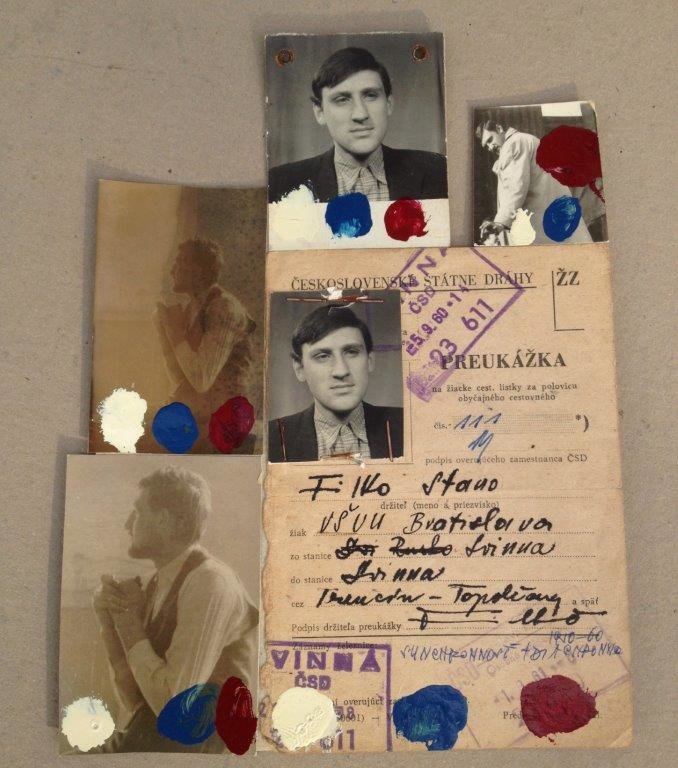System SF: Identity and Guiding system
Foyer & Basement Gallery

SF Railway License / SF Železničná preukážka, 1964
B/W photography, latex paint, paper
21,7 × 16,6 cm
Moving into the intermediary rooms around it, there are a number of works that present important continuities in the Archive SF. Here again it becomes clear how Filko combined the different levels of meaning in his work over many years with everyday objects, using these as a kind of guiding system, also in spatial terms. On the right of the archive room, this guiding system is seen in the form of street signs that Filko overpainted in Monument to Traffic Signs. External Environment – Communication (ca. 1990), using one color from his seven-phase chakra system for each. The structures in the way the paint is applied and the traces of the material beneath unfold a performative aspect that at the same time recalls an iconoclastic gesture. The usual function of these signs is made invisible with paint, and their symbolism is brought into Filko’s own system that now transfers them into a human dimension related to our own bodies.
In the archive room the three-part installation SF Clinical Deaths (1995) is presented, which consists of two drawings and a wooden plank with text, where the years 1945 and 1952 are shown as important cornerstones in Filko’s biography. Filko often told a mythical story about “clinical deaths” that he said he experienced after serious accidents several times in his life. Clinical death is also illustrated in the work on paper where a red figure seems to be lying in a coffin and the word “ego” is added. The periods of time between Filko’s clinical deaths might also represent different states of consciousness, as Filko often hinted when he spoke of different “clones” of his artistic ego. He also expresses this division of his life into different identities with different ways of writing his own name (Filko, Phylko, Phys), as shown on a related work on paper.
The work SF Railway License (1964) shows an officially approved Slovak identity card of Stano Filko to which he added several photo portraits. Filko can be seen in different poses, and both the document and the photographs have additional round spots of paint in white, blue, and red. The three main colors of his system are also the colors of the Slovak national flag, which raises basic questions as to the interpretative authority of the artistic system. Does this represent a fundamental rewriting of the symbolism, an ironic approach, or the affirmation of nationalism?
Upon entering the main room, visitors see a further element of the guidance system: seven wooden boards entitled 7 Chakra Colors (Wooden Formwork) (ca. 1995), each of them displaying a number in the colors of the chakra system.
Monument to Traffic Signs. External Environment – Communication / Pomník značkám. Externé prostredie – komunikácia, 1967/ca. 1990
Installation, paint, wood, metal
Variable dimensions
SF Clinical Deaths / SF Klinické smrte, 1995
Installation, mixed media, piece of wood, drawing, plastic slide sleeve,
122 × 18 × 4 cm, 42 × 29,7 cm, 23 × 27,6 cm
SF Railway License / SF Železničná preukážka, 1964
Collage, B/W photography, latex paint, paper
21,7 x 16,6 cm
FYLKO, ca. 1995
Acrylic, plastic
32 × 41 cm
7 Chakra Colors (Wooden Formwork) / 7 farieb čakier (Drevené debnenie), ca. 1995
Installation, found wooden objects, acrylic, wire
Variable dimensions
All works Courtesy Linea Collection, Bratislava; Layr, Vienna